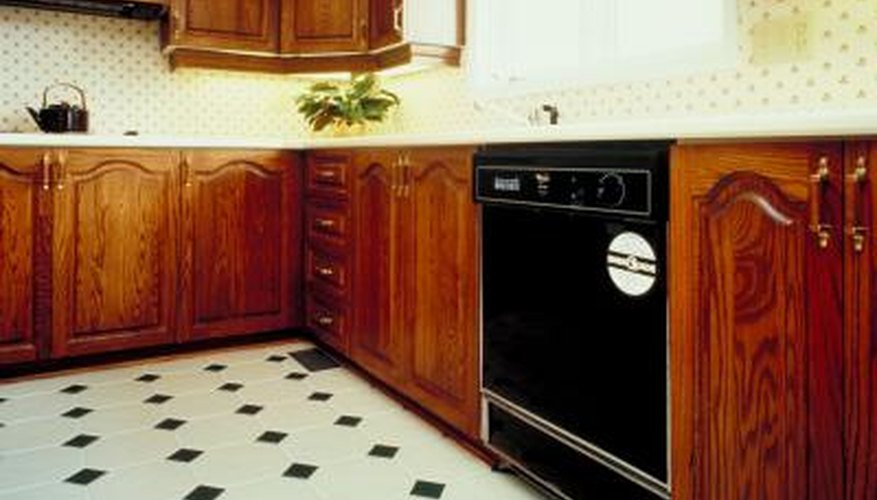Accidents happen -- but that fact is no consolation when accidents happen to your linoleum or vinyl floor, damaging the material. A dropped knife, a high heel puncturing the surface, a moving appliance gouging the floor ... any number of events can leave your linoleum or vinyl flooring with rips, holes and tears. Fortunately, fixing linoleum tears doesn't really require hiring a professional or ripping out the entire surface and laying new covering. With a "stolen" piece of covering from underneath an appliance or from a scrap left over after installation, some linoleum adhesive and seam sealer, you can fix most any linoleum tear or rip.
- Accidents happen -- but that fact is no consolation when accidents happen to your linoleum or vinyl floor, damaging the material.
- With a "stolen" piece of covering from underneath an appliance or from a scrap left over after installation, some linoleum adhesive and seam sealer, you can fix most any linoleum tear or rip.
Clear the area around the tear to provide a obstacle-free work area. Look at the tear or cut closely to determine which method of repair will work best. Try easier repairs before attempting to patch the damaged area.
Dampen a clean, soft cloth with lacquer thinner. Wipe over the damaged area, scrubbing if necessary to remove any dirt or debris present. Dry before proceeding.
Use a blunt knife or small spatula to carefully pry up the edges of the tear or slit in your linoleum, if the rip or tear is large enough to expose the floor underneath the linoleum or vinyl; if you can't see the subfloor through the edges of the tear, do not tear it further. Spread a small amount of linoleum glue -- the exact amount will depend on the size of the tear -- across the flooring beneath.
- Dampen a clean, soft cloth with lacquer thinner.
- Use a blunt knife or small spatula to carefully pry up the edges of the tear or slit in your linoleum, if the rip or tear is large enough to expose the floor underneath the linoleum or vinyl; if you can't see the subfloor through the edges of the tear, do not tear it further.
Press the edges of the tear together, wiping away any excess glue that squeezes out. Place a brick, a heavy book or a similar object on top of the repair to aid the tear in drying flat. Do not remove the weight until the glue is dry -- that will take, typically, several hours. Clean any glue residue on top of the finished repair with a cloth dampened with lacquer thinner.
Smooth smaller tears, after cleaning with lacquer thinner, by pressing the edges of the rip flat. Squirt a thin bead of liquid seam sealer onto the damaged area. Allow the repair to air dry several hours before walking on the area; small tears will appear virtually unnoticeable after completion.
Use a scrap piece of linoleum or vinyl, if you have any available, to create a patch for larger rips and tears. Remove a piece of flooring underneath an appliance or inside a closet if you do not have scrap available. Measure and mark a square section of replacement linoleum, making it slightly larger than the damaged area. Use a hair dryer or pot of very hot water set on the floor to loosen the adhesive beneath the piece you wish to "steal."
- Smooth smaller tears, after cleaning with lacquer thinner, by pressing the edges of the rip flat.
- Use a scrap piece of linoleum or vinyl, if you have any available, to create a patch for larger rips and tears.
Cut through the linoleum or vinyl, according to measurement marks. Peel up the linoleum carefully, using a putty knife or similar tool, to remove.
Place the patch piece on top of the damaged area, making sure to align any patterns as applicable. Use a sharp utility knife to cut through both pieces of linoleum or vinyl floor covering at once, so that the patch and the hole it fits are an exact match.
Remove the damaged flooring piece, using a hair dryer or pan of hot water to again loosen the glue and aid in removal. Scrape any dried glue or residue from the subflooring beneath, once the damaged piece is removed.
Apply a thin layer of linoleum adhesive to the subfloor where the patch will be placed. Put the patch in place, pressing in firmly and wiping away any excess glue that squeezes out. Cover the patch with a heavy book, brick or similar object to hold in place while the patch dries -- at least overnight, for best results. Complete by spreading a seam sealer around the edges and allow to dry again.
- Cut through the linoleum or vinyl, according to measurement marks.
- Cover the patch with a heavy book, brick or similar object to hold in place while the patch dries -- at least overnight, for best results.
TIP
If you can't find an exact replacement for your linoleum or tile, consider an "accent" piece -- a scrap of linoleum of a complementary colour or desirable design. Cover repairs with waxed paper before placing weights on them; if any glue squeezes out, it is easier to remove the waxed paper than the object, which might make the area tear.
WARNING
To fill in large gouges and holes without creating a patch, crumble or grate some linoleum into a powder. Mix with lacquer to make a paste, spread across the blemish and allow to dry. Sand to smooth after completion.
